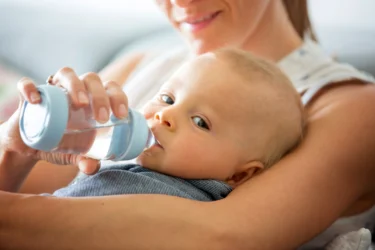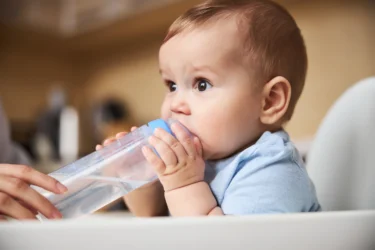Baby Loose Motion: Causes, Home Remedies, and Effective Ways to Stop It Fast
By Dr. Anmol Batra +2 more

Get,

to manage your symptom
Get your,


4 Cr+ families
benefitted

OTP sent to 9988776655



You’ve successfully subscribed to receive
doctor-approved tips on
Whatsapp

Get ready to feel your best.

Hi There,
Download the PharmEasy App now!!


Register to Avail the Offer
Send OTPBy continuing, you agree with our Privacy Policy and Terms and Conditions

Hi There,
Sign up on PharmEasy now!!
Trusted by 4 crore+ families

OTP sent to 9988776655



You have unlocked 25% off on medicines




Code: NU25
By Dr. Anmol Batra +2 more
Table of Contents
It is natural for parents to feel anxious when their baby passes frequent watery stools. However, loose motion (diarrhoea) is quite common in infants and young children and, in most cases, is not a cause for serious concern. It often occurs due to mild infections or dietary changes1. Note that with the right care, most babies recover quickly at home.
In this blog, we will discuss the common causes of loose motion in babies, symptoms to watch for, safe and effective baby loose motion home remedies, diet tips to help your baby recover faster, and when it is important to consult a doctor.

The normal stool pattern (its volume, frequency, and consistency) varies depending on a child’s age, weight, and diet. For example2:
Important: Consistency and colour also matter. While it is normal for young babies (especially breastfed ones) to have soft, sometimes yellow, green, or brown stools with a “seedy” appearance, watery, runny, blood or mucus-filled stools represent a significant change that should be monitored and consulted with a doctor.
Loose motion, or diarrhoea, refers to the passage of loose or watery stools more frequently than usual. Remember, baby loose motion is not a disease in itself but a symptom of various underlying conditions2.
Diarrhoea is often defined as2:
Note: Although most cases of baby loose motion resolve on their own, it can sometimes lead to dehydration causing loss of water and essential electrolytes (like sodium, potassium, and chloride). This imbalance can be serious if not managed promptly, so understanding the signs and providing timely care is crucial2.
Most babies experience loose motions at some point, and while it is often mild, parents should know what is causing it:
Note: Viral, bacterial, and parasitic diarrhoeas are all highly contagious. Infections spread mainly through the stool-hand-mouth route, especially during diaper changes or poor hand hygiene2. Thus, it is important to maintain good hygiene as it helps prevent the spread within the household or daycare.
In babies, it can be tricky to tell what is normal since newborn stools are naturally soft and frequent, sometimes occurring after every feeding2. However, your baby may have diarrhoea if you notice4:
Dehydration is one of the most serious complications of diarrhoea in infants and young children, especially those under 3 years old.
Parents should watch for these warning signs2,4:
Prolonged baby loose motion can even interfere with nutrient absorption, leading to malabsorption. Common symptoms include4:
Loose motion usually gets better with simple care at home. The main goal of how to stop loose motion for babies is to keep your baby hydrated, nourished, and comfortable while their tummy recovers. Below are some safe and gentle baby loose motion home remedies:






Proper feeding during loose motions is important to help your baby recover faster and prevent weakness or malnutrition. If you are wondering how to control loose motion in babies, you should continue to feed your child as recommended for their age (even if they are sick) and ensure they get enough fluids along with nutritious, easily digestible foods5.
| Age Group | Feeding Advice | Recommended Foods |
| Up to 6 months | • Exclusively breastfeed. • Offer breast milk as often as the baby wants, day and night (at least 8-12 times in 24 hrs). • Do not give any other foods or fluids. | Only breast milk |
| 6 months to 12 months | • Continue breastfeeding. • Introduce soft, easily digestible foods. • Offer small, frequent meals. Feed 3 times a day if breastfed or 5 timesper day if not breastfed. | • Undiluted sweetened milk with mashed roti/rice. • Thick dal with added oil and mashed roti/rice/khichdi with vegetables • Sevian, dalia, halwa, or kheer with milk • Mashed, boiled, or fried potatoes without spices • Banana, sapota, mango, or papaya as snacks |
| 12 months to 24 months | • Continue breastfeeding. • Offer soft, energy-rich foods. • Encourage eating even during illness. Feed 5 times per day. | • Thick dal with oil and mashed roti/rice/khichdi with vegetables • Undiluted sweetened milk with mashed roti/rice. • Sevian, dalia, halwa, or kheer with milk • Mashed potatoes without spices • Fruits like banana, sapota, mango, papaya |
| Above 24 months | • Offer regular family meals and healthy snacks. • Ensure foods are soft, mild, and nutritious. Feed 5 times per day. | • Family foods that are non-spicy • Energy-rich, easily digestible dishes • Soft fruits and vegetables |
Additional Tips
When your baby has loose motions, taking a few simple precautions can help prevent the condition from worsening and reduce the risk of dehydration or infection:
Preventing baby loose motion largely depends on maintaining good hygiene, safe feeding practices, and ensuring your child consumes clean, age-appropriate food and water.
Also Read: Vomiting in Kids: Causes, Home Remedies & Treatment Options
You should contact your child’s doctor right away if you notice any of the following1,9:
If your baby’s loose motion lasts more than 2 to 3 days without improvement, seek help as soon as possible1.
Also Read: Rickets in Children: Causes, Symptoms, Types & Treatment
Loose motions in babies and young children are common but should never be ignored, especially if they persist or are accompanied by signs of dehydration or weakness.
Most cases are mild and can be safely managed at home with proper hydration, gentle foods, and good hygiene. However, prompt medical attention is essential if symptoms worsen or the child is very young. Remember, with timely care, safe feeding practices, and preventive hygiene, most children recover quickly and stay healthy.
Also Read: Caring for a Baby with Blocked Nose: Simple Tips for Parents
Mild loose motion usually lasts 2 to 3 days and improves with proper hydration and feeding1. If it continues for more or worsens, consult your paediatrician.
Continue breastfeeding or formula as usual. For older babies, offer soft, easy-to-digest foods like mashed banana, rice gruel, boiled potatoes, moong dal, curd, or applesauce. Avoid sugary drinks, fried foods, or high-fibre foods1,5.
Teething itself does not directly cause diarrhoea, but babies tend to put objects in their mouths, increasing the risk of mild infections that may lead to loose stools10.Therefore, it’s important to maintain good hygiene and clean teething toys regularly.
Overfeeding, especially formula or solids, can upset the baby’s digestive system and lead to watery stools11. Therefore, feed small, frequent meals appropriate for your baby’s age.
Disclaimer: The information provided here is for educational/awareness purposes only and is not intended to be a substitute for medical treatment by a healthcare professional and should not be relied upon to diagnose or treat any medical condition. The reader should consult a registered medical practitioner to determine the appropriateness of the information and before consuming any medication. PharmEasy does not provide any guarantee or warranty (express or implied) regarding the accuracy, adequacy, completeness, legality, reliability or usefulness of the information; and disclaims any liability arising thereof.
Links and product recommendations in the information provided here are advertisements of third-party products available on the website. PharmEasy does not make any representation on the accuracy or suitability of such products/services. Advertisements do not influence the editorial decisions or content. The information in this blog is subject to change without notice. The authors and administrators reserve the right to modify, add, or remove content without notification. It is your responsibility to review this disclaimer regularly for any changes.
Comments

Leave your comment...
You may also like
Comments